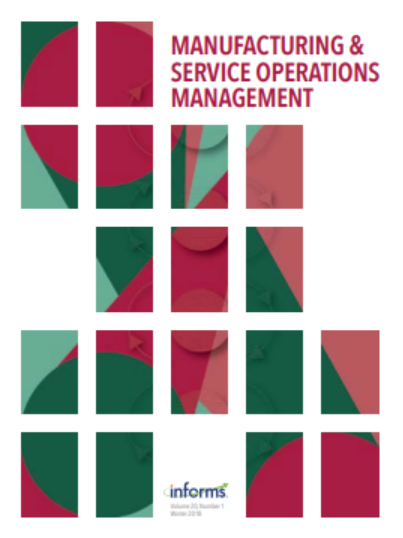Appointment Scheduling Under a Service-Level Constraint
IF 4.8
3区 管理学
Q1 MANAGEMENT
M&som-Manufacturing & Service Operations Management
Pub Date : 2023-01-01
DOI:10.1287/msom.2022.1159
引用次数: 2
Abstract
Problem definition: This paper studies an appointment system where a finite number of customers are scheduled to arrive in such a way that (1) the expected waiting time of each individual customer cannot exceed a given threshold; and (2) the appointment times are set as early as possible (without breaking the waiting time constraint). Methodology/results: First, we show that, under the service-level constraint, a prospective schedule can be obtained from a sequential scheduling approach. In particular, we can schedule the appointment time of the next customer based on the scheduled appointment times of the previous customers. Then, we use a transient queueing-analysis approach and apply the theory of majorization to analytically characterize the structure of the optimal appointment schedule. We prove that, to keep the expected waiting time of each customer below a certain threshold, the minimum inter-appointment time required increases with the arrival sequence. We further identify additional properties of the optimal schedule. For example, a later arrival has a higher chance of finding an empty system and is more likely to wait less than the duration of his expected service time. We show the convergence of the service-level-constrained system to the D/M/1 queueing system as the number of arrivals approaches infinity and propose a simple, yet practical, heuristic schedule that is asymptotically optimal. We also develop algorithms that can help system managers determine the number of customers that can be scheduled in a fixed time window. We compare the service-level-constrained appointment system with other widely studied systems (including the equal-space and cost-minimization systems). We show that the service-level-constrained system leads to a lower upper bound on each customer’s waiting time; ensures a fair waiting experience among customers; and performs quite well in terms of system overtime. Finally, we investigate various extended settings of our analysis, including customer no-shows; mixed Erlang service times; multiple servers; and probability-based service-level constraints. Managerial implications: Our results provide guidelines on how to design appointment schedules with individual service-level constraints. Such a design ensures fairness and incorporates the threshold-type waiting perception of customers. It is also free from cost estimation and can be easily applied in practice. In addition, under the service-level-constrained appointment system, customers with later appointment times can have better waiting experiences, in contrast to the situation under other commonly studied systems. Funding: Z. Yan was partly supported by a Nanyang Technological University startup grant; the Ministry of Education Academic Research Fund Tier 1 [Grant RG17/21] and Tier 2 [Grant MOE2019-T2-1-045]; and Neptune Orient Lines [Fellowship Grant NOL21RP04]. Supplemental Material: The online supplement is available at https://doi.org/10.1287/msom.2022.1159 .服务水平约束下的预约调度
问题定义:本文研究了一个预约系统,其中有限数量的顾客被安排到达,并且:(1)每个顾客的期望等待时间不能超过给定的阈值;(2)尽早设置预约时间(不打破等待时间限制)。方法/结果:首先,我们证明了在服务水平约束下,可以通过顺序调度方法获得预期调度。特别是,我们可以根据前一个客户的预约时间来安排下一个客户的预约时间。然后,利用暂态排队分析方法,运用多数化理论对最优预约调度的结构进行了解析表征。我们证明,为了使每个顾客的期望等待时间低于某一阈值,所需的最小预约间隔时间随着到达顺序的增加而增加。我们进一步确定了最优调度的附加性质。例如,较晚到达的人更有可能找到空系统,并且等待的时间更有可能少于他预期的服务时间。我们展示了服务水平约束系统对D/M/1排队系统趋近于无穷时的收敛性,并提出了一个简单而实用的启发式渐近最优调度。我们还开发了算法,可以帮助系统管理人员确定在固定时间窗口内可以安排的客户数量。我们将服务水平约束的预约系统与其他广泛研究的系统(包括等空间和成本最小化系统)进行了比较。我们证明了服务水平约束的系统会导致每个顾客等待时间的下上界;确保顾客有公平的等待体验;在系统加班方面表现得很好。最后,我们调查了我们分析的各种扩展设置,包括客户缺席;混合Erlang服务时间;多个服务器;以及基于概率的服务水平约束。管理意义:我们的结果为如何设计具有个人服务水平约束的预约安排提供了指导。这样的设计既保证了公平性,又融入了顾客阈值式的等待感知。它也不需要成本估算,可以很容易地在实践中应用。此外,在服务水平约束的预约制度下,预约时间较晚的客户可以获得更好的等待体验,而不是在其他常见的研究制度下。项目资助:Yan获得了南洋理工大学创业基金的部分资助;教育部学术研究基金一级[资助RG17/21]和二级[资助MOE2019-T2-1-045];和Neptune Orient Lines [Fellowship Grant NOL21RP04]。补充材料:在线补充材料可在https://doi.org/10.1287/msom.2022.1159上获得。
本文章由计算机程序翻译,如有差异,请以英文原文为准。
求助全文
约1分钟内获得全文
求助全文
来源期刊

M&som-Manufacturing & Service Operations Management
管理科学-运筹学与管理科学
CiteScore
9.30
自引率
12.70%
发文量
184
审稿时长
12 months
期刊介绍:
M&SOM is the INFORMS journal for operations management. The purpose of the journal is to publish high-impact manuscripts that report relevant research on important problems in operations management (OM). The field of OM is the study of the innovative or traditional processes for the design, procurement, production, delivery, and recovery of goods and services. OM research entails the control, planning, design, and improvement of these processes. This research can be prescriptive, descriptive, or predictive; however, the intent of the research is ultimately to develop some form of enduring knowledge that can lead to more efficient or effective processes for the creation and delivery of goods and services.
M&SOM encourages a variety of methodological approaches to OM research; papers may be theoretical or empirical, analytical or computational, and may be based on a range of established research disciplines. M&SOM encourages contributions in OM across the full spectrum of decision making: strategic, tactical, and operational. Furthermore, the journal supports research that examines pertinent issues at the interfaces between OM and other functional areas.
 求助内容:
求助内容: 应助结果提醒方式:
应助结果提醒方式:


